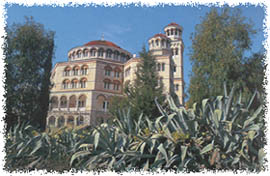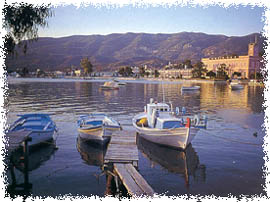|
|
|
|
|||||
ROUTES
|
Aegina - Souvala - Palea Hora - Agios Nektarios Monastery The road that goes through the capital leads to the populous community of Kipseli with traditional two - storey houses and a lovely central square. Visitors to the area can swim at Kavouropetra. You can continue to the seaside area of Leonti, where the original monastery of Hrissoleontissa stands. The same road continues to the farm town of Vathi and winds up to the small harbor of Souvala, a tourist resort in progress, with a wonderful beach. The area boasts a warm sulphurous healing spring. A by-pass from the seaside road to Vagia leads to Agius, a village smothered in pine - trees, famous for its water jug potters and the church of the Apostle Crispus, a disciple of Apostle Paul.
The dazzling white Monastery of Agios Nektarios was built in 1904 - 10 by the Metropolitan of Pentalpoli, Nektarios. Palea Hora was built on a craggy rock, when in 896 AD the harbor town suffered a terrible invasion by Saracen pirates and the frightened inhabitants retreated towards the inner land. Aegina - Temple of Aphaea - Agia Marina. Just before Agia Marina, on the top of a pine - clad hill, lie the ruins of the Doric Temple of Athena Aphaea. The sanctuary site seems to have been used as a place of worship as far as 1300 BC. The first sanctuary was nothing more than a natural monument, of which only one narrow foundation has survived. From the second, there are only traces of an altar on the east side, since in 510 BC a great fire destroyed the temple's roof completely and the Aiginetans tore it down, along with other parts of the sanctuary building. The sanctuary took on its final form around 500 - 480 BC. It was raised to a single level and extensive landfills were done in order to expand the sanctuary, thus making it a unique achievement of its time. Battles were pictured on both pediments of the main temple. In the center a figure of Athena predominated. West of the temple there is a small museum with rare painted copies. The road runs down to the settlement of Agia Marina. When you enter the main street, you will realize why this is a busy place: there are souvenir shops, hotels, jeweler's shops etc. Those of you who decide to leave Agia Marina the same day, you will not be disappointed during the rest of your trip. First you will come across the village Alones, built in a green valley, with lovely little taverns. The seaside road continues to the old village Kilindros and winds up to the small port of Portes, a seaport of the ancient settlement of Lazarides.
|
| |General Info| | |History| | |Routes| | |Information| | |Map| |
| |Hotels| | |Restaurants| | |Cafe| | |Greek Tourism| |

